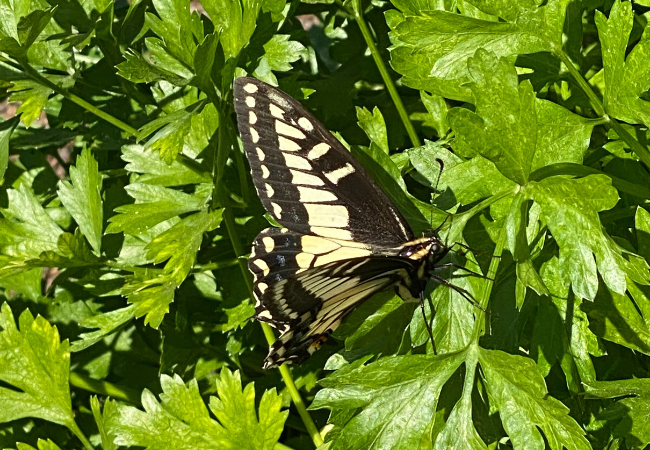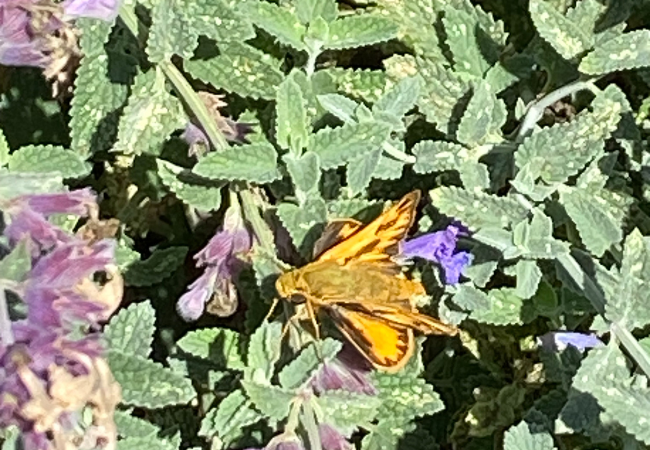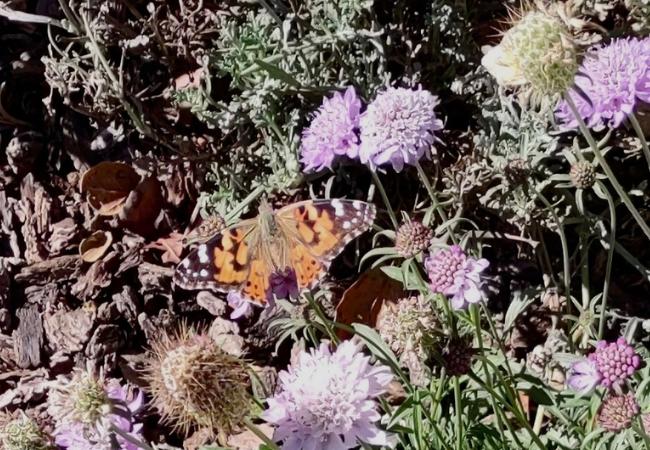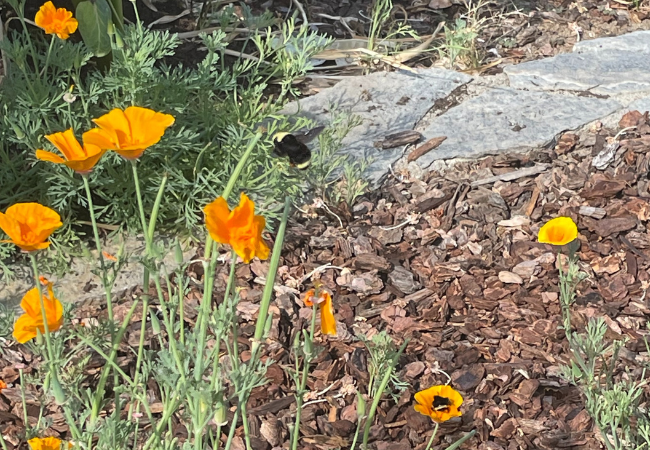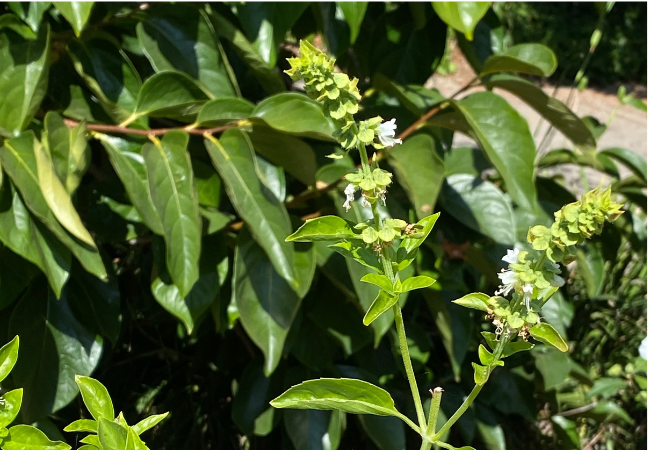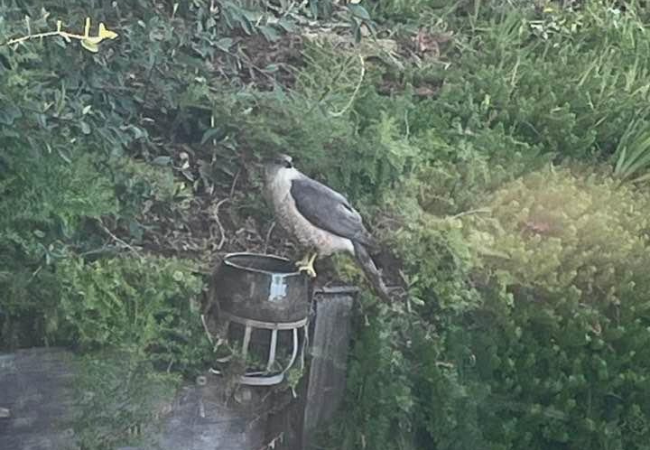Why It's Important
“…we now need to save nature where people are”
Doug Tallamy, T. A. Baker Professor of Agriculture, Department of Entomology and Wildlife Ecology, University of Delaware
Whether we grow our plants in pots on an apartment balcony or in large beds in a garden, we've all heard that it's important to conserve water and preserve our local environment by choosing native, drought resistant plants, reducing our lawns, and removing invasive plants that compete with our regional vegetation. We also know that plants, and especially trees, help cool our local environment and absorb pounds of carbon dioxide from the air, replacing it with oxygen. But did you know there is another equally important purpose that our personal outdoor spaces can fill?
We can provide food, shelter and water for a wide variety of wildlife that can be critical for its survival. You may think “What difference can one person's balcony penstemon plant really make?” But consider a migrating hummingbird looking for flower nectar and finding that its usual open field is now a large parking lot. That penstemon on your balcony can help sustain the bird to the next food source on its way. There are many examples of how small actions in our own open spaces can increase food and habitat for wildlife. In turn, helping to conserve the diversity and numbers of our wildlife, even those only visiting shortly during migration, will have an important impact on our larger environment. All living things from microbes to mountain lions are interdependent. Even your annoying aphids can be food for birds!
The Habitat Garden: What is it?
The habitat garden is one that uses a variety of native plants, natural materials and sources of water to create places of food, shelter and nesting sites for pollinators (birds, bees, other insects) and other wildlife to thrive. Many articles, guides and entire books have been written on steps you can take to provide these elements for wildlife (see the Reference list below for a few of them). Here we will talk about some simple easy steps you can take to get started.
Your habitat garden will be less manicured, with reduced lawns, less pruning of trees and shrubs to provide limbs for bird perching and protected shelter areas, and clear areas for insect and bee nesting. A good home for wildlife!
Some First Steps You Can Take….
Provide Food and Water
- Plant California native plants, particularly the specific species that provide food for the insects, butterflies and birds in your area. We mention California native plants in particular as they have evolved and adapted over time to grow well in our climate, and native bees and other species also have evolved to feed on these plants. Examples include the California poppy, California fuchsia, penstemon, toyon, salvia, and common sunflowers. Some important pollinators feed only on particular plant species, so it's good to focus on those if you have enough space (e.g. milkweed for the caterpillars of Monarch butterflies, an oak tree for moths). Many non-native flowering plants are also beneficial for our local pollinators (for example lavender, catmint, and cosmos).
- Include multiple plants to the extent you have room, but even one or two plants on your balcony will attract and feed pollinators! Many pollinator plants will do well in pots, so you don't have to have a yard to support beneficial insects like butterflies and hummingbirds. As examples, salvia, catmint, cosmos, poppies, cone flowers and lavender are all easy to grow in pots and attract a variety of bees, butterflies and hummingbirds.
- Reduce or remove your lawn, and use that space to plant native plants. Even reducing a lawn a small amount can free up space for some food producing native plants. This also reduces the amount of water needed to irrigate, as native plants typically require much less water to thrive. There may even be rebates available in your area to help with replacing your lawn.
- Add a seasonal variety of native plants for year round food source and color to enjoy. You can find different species of native plants that flower and produce seeds or berries for wildlife food production year round. The California Native Plant Society and other sources have lists of plants for different seasons.
Spring: California lilac (Ceanothus), monkey flower, penstemon, California poppy, catmint
Summer: Sunflowers, California fuschia, salvia
Fall: Many plants will continue to bloom through fall, such as California fuschia and salvia. Fall is also a good time to plant perennial native plants, as the cooler weather will permit less watering while their roots grow.
Winter: Toyon (berries in winter; flowers in spring), Nicotiana
- Let a portion of flowering plants and vegetables go to seed rather than removing them at the end of the season. And don't remove your native plant flowers as they begin to fade; let them go to seed. Allow some of your vegetable plants to flower for the pollinators in your yard. Bees love basil and arugula flowers.
- Share your homegrown produce. Squirrels and birds can be a nuisance when our fruit trees and vegetable gardens begin producing. But consider sharing some of your fruit and vegetables with them rather than excluding them or picking everything – there are usually more than enough plums and tomatoes! When you are planning your vegetable garden, add an extra plant or two if possible to share with the wildlife.
-
Put out a shallow water source with rocks and stones for bees and birds, especially during the warm summer months. The stones provide a landing place for insects and birds. Butterflies cannot land on water but use muddy soil to drink (called “puddling”). You can make a puddling dish by placing a shallow dish, or even a pie tin, in the ground or on a pedestal. Fill it with muddy soil, and check it later to keep it moist.
Give Them Shelter
- Plant layers of foliage for shelter and nesting areas (groundcovers to mid-height and tall shrubs, as well as trees). Allow some leaf litter to remain on the ground as shelter. Some insect larvae spin cocoons in leaf litter to complete their life cycle. Plant native ground cover plants in larger areas; this will help reduce weed growth too! Leave some bare ground around plants and trees to provide nesting sites for ground nesting native bees.
- Leave some downed, brush piles for shelter for birds, insects, small mammals. While it's important for wildfire safety to not let deep amounts of downed brush to accumulate, small amounts of brush, some distance from your house, provides critical shelter for insects and birds.
Garden Practices
Use Beneficial Practices
- Use pesticides very rarely if ever, and only when absolutely necessary for a severe pest infestation, at the proper time of year and no more than instructions require.
- Hand pull or cut weeds and invasive plants rather than using herbicides.
Some Practices to Avoid
- Replace any white exterior lights around your home. White night lights kill great numbers of insects by blinding them, causing collisions, dehydration and other problems. Reducing light pollution is actually a fairly easy step and has a large beneficial impact. Just change outdoor white light bulbs to yellow LED bulbs and use motion activated security lights. This can increase your own enjoyment of the night sky too.
- Don't plant lawn below trees, as it not only can cause root rot from over watering the tree but also provides no benefit for habitat. Instead, leave soil bare under trees or plant a native ground cover.
- Do not leave out pet food or human food. Provide food for birds and mammal wildlife by planting seed and fruit producing plants and trees. Leaving food out can be harmful to mammal wildlife and also may make them accustomed to it and aggressive in looking for more (this is often seen with raccoons). Compost bins should be covered so as not to inadvertently feed unwanted wildlife.
The Result?
Since most of the land in our country is privately owned, supporting wildlife and our environment cannot be done solely through parks, protected corridors and nature preserves. Private lands, including our own yards and balconies, are key sources of habitat and food for the insects and mammals that pollinate our own food sources and are vital parts of our environment. So enjoy your beautiful, more natural garden and observe the wildlife that shares it with you. You are preserving nature at the same time as providing a place of respite and enjoyment for yourself and others!
References
- California Native Plant Society. https://www.cnps.org/gardening/native-design-basics/habitat-gardening
- National Wildlife Federation – tips on creating a wildlife habitat. https://www.nwf.org/Garden-for-Wildlife/About/Resources/tips
- National Wildlife Federation – Saving Pollinators One Garden at a Time. https://www.nwf.org/Garden-for-Wildlife/About/Resources/Saving-Pollinators
- UC Master Gardener Program of Monterey Bay
https://ucanr.edu/blogs/blogcore/postdetail.cfm?postnum=23513
https://ucanr.edu/blogs/blogcore/postdetail.cfm?postnum=20150
https://ucanr.edu/blogs/blogcore/postdetail.cfm?postnum=22539
- UC Master Gardener Program of Sonoma County
https://sonomamg.ucanr.edu/Sustainable_Home_Gardening/Protect_-_Encourage_Wildlife/
- UC Master Gardener Program of Contra Costa County
https://ccmg.ucanr.edu/News_to_Grow_By/?story=2461
- UC Master Gardeners of Tuolumne County – Habitat Gardening
https://ucanr.edu/sites/Tuolumne_County_Master_Gardeners/files/284974.pdf
- Pacific Horticulture/UC Berkeley Urban Bee Lab
https://pacifichorticulture.org/articles/gardening-for-native-bees/
- Pacific Horticulture - Pollinators
- Pacific Horticulture – Guide to Insect Hotels
https://pacifichorticulture.org/articles/web-extra-a-resource-guide-to-insect-hotels/
- Pacific Horticulture – Hedgerows as Habitat
https://pacifichorticulture.org/articles/hedgerows-as-habitat/
- Cornell Lab of Ornithology/Nest Watch – Bird Nest Boxes and Structures
https://nestwatch.org/learn/all-about-birdhouses/
- UC Berkeley Urban Bee Lab
Providing native bees with water, habitat, and food with plants. http://www.helpabee.org/seasonal-bee-gardening.html
Best bee plants for California. http://www.helpabee.org/best-bee-plants-for-california.html
